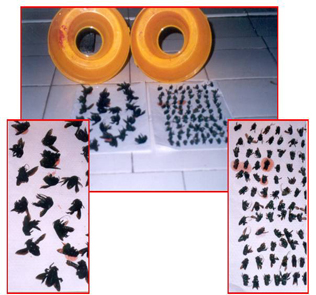Pollinators
Bees are the main pollinators of nature, and Brazil as being a country with a strong agribusiness must always be open to new ways to produce crops in a sustainable way.
Semiochemicals are chemical substances that enable communication between living things found in nature. The allelochemicals enable communication between individuals of different species. From the economic point of view the most important interactions observed are insect pests x tillage and pollinators insects x tillage.
Insect pest case
The transition from subsistence farming to commercial generally increases the crop area, deforests and unbalances the biome. The concentration of the same species of plant in a large area can release allelochemicals in such quantity that generates a great migration of the same predatory insects to the area of planting, destroying the crop. In many cases the solution is the use of insecticides / pesticides that run into a lot of environmental, health and quality problems required for export.
Semiochemicals have emerged as promising components in integrated pest management, particularly in monitoring insect populations and mass collection of these. This way It’s possible to eliminate or greatly reduce the amount of insecticide employed. They may be used to assist in the pollination process, especially vegetables, which are naturally self-pollinated compromised.
Insect pollinator case: Orchid and Passion Bee
The LASAPE developed a mixture with characteristics of a non-natural alelochemical, which was put to test in an orchard in the state of Rio de Janeiro.
The test found:
- Selective attraction of Eulaema nigrita and Euglossa pleosticta by LASAPE/IQ-UFRJ mixture.
- These insects have economic importance, for being pollinators in passion fruit and orchids crops.
- The use of the mixture LASAPE/IQ-UFRJ in these cultures, could increase the population density of these pollinators, especially in flowering time.


The field test

The field test used McPhail traps. Important factors in trapping:
- Type of trap (design, size, color, etc).
- Distribution of traps in the field (density, distance between them, the height from the ground, exposure time).
- Saturation of traps.
- Influence of semiochemical's formulation.
The identification of species captured in a field test confirmed:
- Eulaema nigrita
- Euglossa pleosticta
- Euglossa securigera
- Euglossa sapphirina
In this set there are two main genres of Euglossini: Eulaema and Euglossa.
The Euglossa Bees:
- Are attracted to orchids seeking nectar, pollen and volatile compounds of these flowers.
- They are tropical bees, usually with intense metallic shine.
- Have extremely long tongue and undeveloped sociability.
- The Eulaema include Euglossine which are larger and less metallic coloring.
The Eulaema nigrita is an important pollinator in the culture of passion fruit that presents 5 stamens and three stigmas on top plan, which hinders their pollination. The self-pollination is rare, producing smaller fruits with few seeds.
The Euglossas are important pollinators of orchids.
See Technological Consultancy for more information.




